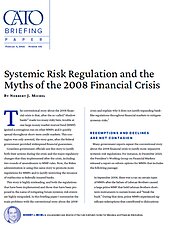1. For a comprehensive critique of the conventional story, including its pervasive use and a detailed explanation of why it does not justify implementing widespread bank-like regulations throughout financial markets, see Norbert J. Michel, “The Contagion Concoction: The Truth about Runs and the Great Financial Crisis,” CMFA Working Paper no. 006, February 2, 2022, https://www.alt‑m.org/2022/02/02/the-contagion-concoction-the-truth-about-runs-and-the-great-financial-crisis-cmfa-working-paper-no-006/.
2. “Overview of Recent Events and Potential Reform Options for Money Market Funds,” President’s Working Group on Financial Markets, December 2020, p. 4, https://home.treasury.gov/system/files/136/PWG-MMF-report-final-Dec-2020.pdf.
3. “Report on Stablecoins,” President’s Working Group on Financial Markets, the Federal Deposit Insurance Corporation, and the Office of the Comptroller of the Currency, November 2021, p. 12, https://home.treasury.gov/system/files/136/StableCoinReport_Nov1_508.pdf.
4. “Overview of Recent Events and Potential Reform Options,” p. 4n4.
5. “Money Market Fund Reform Options,” President’s Working Group on Financial Markets, October 2010, pp. 11–13, https://www.treasury.gov/press-center/press-releases/Documents/10.21%20PWG%20Report%20Final.pdf.
6. “Proposed Recommendations Regarding Money Market Mutual Fund Reform,” Financial Stability Oversight Council, November 2012, p. 25, https://www.treasury.gov/initiatives/fsoc/Documents/
Proposed%20Recommendations%20Regarding%20Money%20Market%20Mutual%20Fund%20Reform%20-%20November%2013,%202012.pdf.
7. “Proposed Recommendations Regarding Money Market Mutual Fund Reform,” pp. 25–26.
8. “Money Market Fund Reform Options,” p. 12.
9. Richard Anderson and Charles Gascon, “The Commercial Paper Market, the Fed, and the 2007–2009 Financial Crisis,” Federal Reserve Bank of St. Louis Review 91, no. 6 (November/December 2009): 590, https://files.stlouisfed.org/files/htdocs/publications/review/09/11/Anderson.pdf.
10. The authors identify riskier programs “based on observable program characteristics, program type, sponsor type, and macro-financial variables.” Daniel M. Covitz, Nellie Liang, and Gustavo A. Suarez, “The Evolution of a Financial Crisis: Collapse of the Asset-Backed Commercial Paper Market,” Journal of Finance 68, no. 3 (June 2013): 818.
11. Response to Questions Posed by Commissioners Aguilar, Paredes, and Gallagher, Division of Risk, Strategy, and Financial Innovation U.S. Securities and Exchange Commission, November 30, 2012, p. 7, https://www.sec.gov/files/money-market-funds-memo-2012.pdf.
12. An even larger problem for any contagion story that starts with the Lehman Brothers’ failure is that, according to the SEC, investors had already started redeeming shares in prime MMFs days before the Lehman failure. Response to Questions Posed by Commissioners Aguilar, Paredes, and Gallagher, p. 7.
13. Nicola Cetorelli and Stavros Peristiani, “The Role of Banks in Asset Securitization,” Federal Reserve Bank of New York Economic Policy Review, July 2012, p. 58, https://www.newyorkfed.org/medialibrary/media/research/epr/12v18n2/1207peri.pdf. Also see Melanie L. Fein, “The Shadow Banking Charade,” Working Paper, February 15, 2013, https://papers.ssrn.com/sol3/papers.cfm?abstract_id=2218812.
14. Cetorelli and Peristiani, “The Role of Banks in Asset Securitization,” p. 58.
15. Viral V. Acharya, Philipp Schnabl, and Gustavo Suarez, “Securitization Without Risk Transfer,” Journal of Financial Economics 107, no. 3 (March 2013): 519–20, https://www.sciencedirect.com/science/article/abs/pii/S0304405X12001894.
16. Acharya et al., “Securitization Without Risk Transfer,” p. 522.
17. Authors calculations using data on Table 1 (panel B) in Acharya et al., “Securitization Without Risk Transfer,” p. 522, and ABCP data from the Federal Reserve. See, Board of Governors of the Federal Reserve System (US), Asset-Backed Commercial Paper Outstanding [ABCOMP], retrieved from FRED, Federal Reserve Bank of St. Louis, January 6, 2022, https://fred.stlouisfed.org/series/ABCOMP.
18. Stefan Jacewitz and Haluk Unal, “Shadow Insurance? Money Market Fund Investors and Bank Sponsorship,” Federal Deposit Insurance Corporation Center for Financial Research, Working Paper 2020-03, June 2020, forthcoming in the Review of Corporate Finance Studies, p. 5, https://www.fdic.gov/analysis/cfr/working-papers/2020/cfr-wp2020-03.pdf.
19. Interestingly, Fed Chairman Ben Bernanke’s statement to the Financial Crisis Inquiry Commission notes that “A large portion of the investments of these [money market] funds were in short-term wholesale funding instruments issued or guaranteed by commercial banks.” See Statement by Ben S. Bernanke, Chairman Board of Governors of the Federal Reserve System before the Financial Crisis Inquiry Commission, Washington, DC, September 2, 2010.
20. “What Types of Asset Are Used as Collateral in the Repo Market?,” International Capital Markets Association, 2021, https://www.icmagroup.org/Regulatory-Policy-and-Market-Practice/repo-and-collateral-markets/icma-ercc-publications/frequently-asked-questions-on-repo/6‑what-types-of-asset-are-used-as-collateral-in-the-repo-market/; “US Repo Market Fact Sheet,” Securities Industry and Financial Markets Association, 2022, https://www.sifma.org/resources/research/us-repo-market-fact-sheet/; “Repo Market Fact Sheet,” Securities Industry and Financial Markets Association, 2014, https://www.sifma.org/wp-content/uploads/2017/05/us-repo-fact-sheet-2014.pdf; and Viktoria Baklanova, Cecilia Caglio, Marco Cipriani, and Adam Copeland, “The U.S. Bilateral Repo Market: Lessons from a New Survey,” Office of Financial Research, January 13, 2016, https://www.financialresearch.gov/briefs/files/OFRbr-2016–01_US-Bilateral-Repo-Market-Lessons-from-Survey.pdf.
21. Viktoria Baklanova, Isaac Kuznits, and Trevor Tatum, “Primer: Money Market Funds and the Repo Market,” Division of Investment Management’s Analytics Office of the U.S. Securities and Exchange Commission, February 18, 2021, https://www.sec.gov/files/mmfs-and-the-repo-market-021721.pdf.
22. In both the tri-party and bilateral repo market segments, some transactions are “cleared,” meaning that the counterparties transfer risk to a third party (a clearing bank). See David Bowman, Joshua Louria, Matthew McCormick, and Mary-Frances Styczynski, “The Cleared Bilateral Repo Market and Proposed Repo Benchmark Rates,” February 27, 2017, https://www.federalreserve.gov/econresdata/notes/feds-notes/2017/cleared-bilateral-repo-market-and-proposed-repo-benchmark-rates-20170227.html.
23. Baklanova et al., “Primer: Money Market Funds and the Repo Market.”
24. Baklanova et al., “Primer: Money Market Funds and the Repo Market.”
25. See Michel, “The Contagion Concoction,” pp. 53–60. Also see Fein, “The Shadow Banking Charade,” pp. 48–73.
26. Charles Calomiris and Stephen Haber, Fragile By Design: The Political Origins of Banking Crises & Scarce Credit (Princeton: Princeton University Press, 2014), p. ix.
27. Norbert J. Michel and John L. Ligon, “Basel III Capital Standards Do Not Reduce the Too-Big-to-Fail Problem,” Heritage Foundation Backgrounder no. 2905, April 23, 2014, http://thf_media.s3.amazonaws.com/2014/pdf/BG2905.pdf; and Acharya et al., “Securitization Without Risk Transfer.”
28. See J. Friedman and K. Wladmir, Engineering the Financial Crisis: Systemic Risk and the Failure of Regulation (Philadelphia: University of Pennsylvania Press, 2011), chap. 2, p. 81.
29. While it may be tempting to argue that banking—or a market economy itself—is inherently unstable, the record shows that financial crises are not inherent to market economies or to the production of bank debt. In general, market economies other than the United States have performed with fewer banking crises, and most U.S. crises have been directly linked to poorly designed banking and currency regulations. See George Selgin, “Misunderstanding Financial History,” Alt‑M, July 11, 2013, https://www.alt‑m.org/2013/07/11/misunderstanding-financial-history/.


